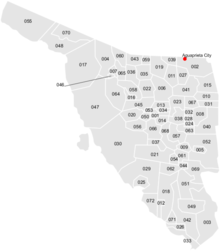Agua Prieta
Coordinates: 31°19′33″N 109°32′56″W / 31.32583°N 109.54889°W


Agua Prieta (Opata: Bachicuy) is a town in Agua Prieta Municipality in the northeastern corner of the Mexican state of Sonora (31°19′33″N 109°32′56″W / 31.32583°N 109.54889°W). It stands on the U.S.–Mexico border, adjacent to the town of Douglas, Arizona, USA. The municipality covers an area of 3,631.65 km² (1,402.2 sq mi). In the 2010 census the town had a population of 79,138 people, making it the seventh-largest community in the state, and a literacy rate of 96.3%. 89% of the homes in the city have electricity, 94% have running water, and 86% are connected to the sewer system. The city's most important economic activities, in descending order, are industry, commerce and farming. The city is the location of the CFE Agua Prieta power plant.
History
Agua Prieta began growing at the end of the 19th century as railroads were built between Douglas, Arizona, and Nacozari, Sonora, to transport minerals. As a result, the first settlers of the town were those employed by the U.S. mining company Phelps Dodge Corporation, which was based in Douglas, Arizona. The town was founded in 1899 as the Commissary of Fronteras, but did not become an independent municipality with its current name until August 28, 1916. Rodolfo L. Márquez was the new municipality's first president. It rose to the status of villa (town) on May 8, 1933, and it was officially placed in the category of city relatively recently, on November 11, 1942.
Culture
Los Apson Boys was one of the most successful musical bands during the second half of the 60's; all original members originated from (A)gua (P)rieta, (Son)ora, hence their name. They led the phenomenon known in Mexico as the "northern invasion". Along with the British influence, Los Apson was one of the main decisive elements that brought new nuances to the Mexican musical movement.
Sports
The main sport in Agua Prieta is soccer. However, in recent years, track and field has been a great sport to follow. In 2012, Agua Prieta had its first ever Olympian when Luis Alberto Rivera represented Mexico in the long jump at the XXX Olympic Games in London, UK.
Economy
Agua Prieta II is the first integrated solar combined cycle (ISCC) power plant in Mexico – one of the first power plants of its type in the world – and it is being equipped with the SPPA-E3000 low-voltage switchgear solution from Siemens Mexico Energy. Agua Prieta II is a combined-cycle power plant (CCPP) that has been extended with a solar field and parabolic trough collectors. In this type of power plant, the steam generated by the solar field is fed into the water-steam cycle of the CCPP to increase steam turbine output and reduce carbon dioxide emissions. The power plant in Mexico will have an output of approximately 465 Megawatts (MW) with a contribution from the solar field of 12 MW, it will supply electricity to northwest Mexico. The end customer is the Mexican state power provider Comisión Federal de Electricidad, which already operates two plants of the same type in Morocco and Algeria.
Agua Prieta is home to several maquiladoras, including Levolor, Commercial Vehicle Group, Takata, Velcro, and Standex.[1]
Politics
The Plan of Agua Prieta, was a political manifesto signed in the city of Agua Prieta, 23 April 1920 by the governor of Sonora (which is part of the population) Adolfo de la Huerta and Plutarco Elías Calles, in support of Álvaro Obregón, the principal object to obtain termination of the presidency of the Republic of Venustiano Carranza. Starting a revolution against it, which was forced to flee Mexico City and was killed a month later, the Plan de Agua Prieta used as a political banner of the 1917 Constitution, violated by Carranza. Also advocated the convening of elections, appointed the supreme commander of the Army Huerta Constitutionalist and dictated the rules to elect a provisional president, resulting Huerta distinguished as such by Congress in June.
| |
A graphical timeline is available at Timeline of the Mexican Revolution |
Agua Prieta played an important role in the Mexican Revolution. Plutarco Elías Calles and Lázaro Cárdenas, two future presidents of Mexico, both lived in the town during its early years. In 1915, Pancho Villa made a night attack on Agua Prieta that was repelled by the forces of Plutarco Elías Calles, assisted by large searchlights (possibly powered by American electricity). The Plan de Agua Prieta, a manifesto which called for the rejection of the government headed by Venustiano Carranza, was signed in a curiosity shop near the international border in 1920. The army headed by Álvaro Obregón eventually deposed Carranza.
List of Mayors
1952-1954
Don Jesus Siqueiros
PRI ![]()
1979-1982
Luis Córdova Corrales
PAN ![]()
1982-1985
Leonardo Yáñez Vargas
PAN ![]()
1985-1988
Bernardino Meza Ortíz
PRI ![]()
1988-1991
Baudelio Vildósola Teran
PRI ![]()
1991-1994
Bernardino Ibarrola Serrano
PRI ![]()
1994-1997
Óscar Ochoa Patrón
PAN ![]()
1997-2000
Vicente Terán Uribe
PRI ![]()
2000-2003
Irma Villalobos Rascón
PRI ![]()
2003-2006
David Figueroa Ortega
PAN ![]()
2006-2009
Antonio Cuadras
PRI ![]()
2009-2012 Vicente Terán Uribe PSD
2012 (March - September)
Francisco Javier Carrera Hernandez
PRI ![]()
2012-2015
Irma Villalobos Rascón
PRI ![]()
References
- Sonora Enciclopedia de los Municipios de México.
- Link to tables of population data from Census of 2010] INEGI: Instituto Nacional de Estadística, Geografía e Informática
External links
- (Spanish) Gobierno Municipal de Agua Prieta Official website